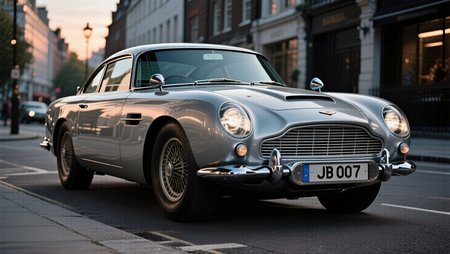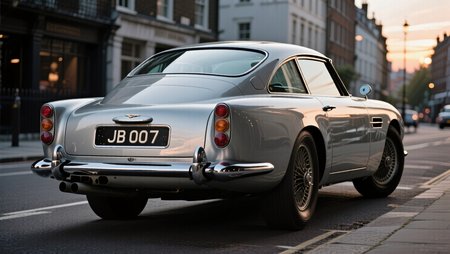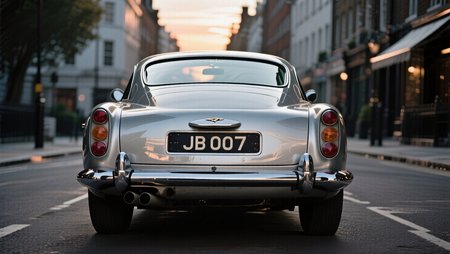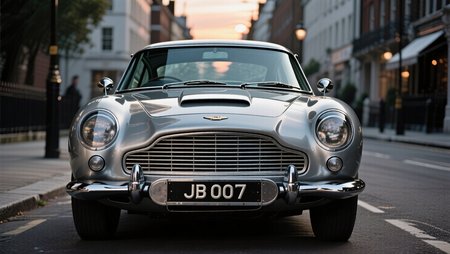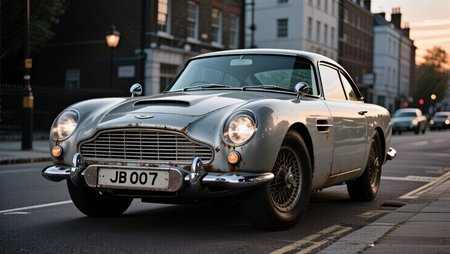The Silver Birch Icon: A Definitive History of the Aston Martin DB5 and its Enduring Bond with 007
The 1964 Aston Martin DB5 holds a unique and enduring status as arguably "the most famous car in the world," an icon forged in the crucible of cinematic history. Its sixty-year association with the character of James Bond began with the 1964 film
Goldfinger, a partnership that catapulted both the car and its manufacturer to unprecedented global fame.
The Car and its Casting
Before its life as a spy's vehicle, the DB5 was a significant automobile in its own right. Introduced in 1963 as a refined evolution of the preceding DB4, it featured a more powerful 4.0-litre, all-aluminium straight-six engine producing 282 bhp, and greater luxury appointments, cementing its status as a premier British Grand Tourer. Its selection for
Goldfinger was a pivotal moment. The film's producers, seeking a more contemporary vehicle than the DB Mark III featured in Ian Fleming's novel, had to persuade a reluctant Aston Martin to supply two cars for the production. This decision would become one of the most successful instances of product placement in history.
The film's creative team, led by production designer Ken Adam and special effects supervisor John Stears, elevated the car from mere transport to a co-star. They expanded on Fleming's modest ideas, conceiving a spectacular arsenal of gadgets designed for cinematic impact. This included the iconic passenger ejector seat, twin Browning machine guns concealed behind the front indicators, a retractable rear bullet-proof screen, revolving number plates, and dispensers for an oil slick and smoke screen.
The Original Bond Cars: A Complex Provenance
Four original cars are central to the Goldfinger and Thunderball story. For filming, EON Productions used two DB5s:
The "Effects Car" (DP/216/1): This was the original DB5 prototype, fitted with the full suite of gadgets for close-up shots. Its history is the most dramatic; after being sold and resold, it was stolen from a secure aircraft hangar in Boca Raton, Florida, in June 1997. Despite a multi-decade investigation and credible leads suggesting it is in a private collection in the Middle East, it remains missing, with its current value estimated at over $25 million.
The "Road Car" (DB5/1486/R): A standard production car used for the driving and chase sequences. After filming, it was fitted with gadgets by the Aston Martin factory for promotional use. It was sold in 2010 for $4.6 million to American collector Harry Yeaggy, who continues to display it at events.
The film's explosive popularity led EON to commission two more identical, gadget-equipped DB5s from the factory purely for promotional work. Though they never appeared on screen, they are considered genuine Bond cars. One of these, DB5/2017/R, now resides in the Louwman Museum in the Netherlands. The other, DB5/2008/R, was sold in August 2019 for a staggering $6.385 million, setting a world auction record for a DB5 and demonstrating the immense "provenance premium" associated with the Bond name.
Cultural Impact and Modern Legacy
The "Bond Effect" was immediate. Sales of the DB5 surged, and Aston Martin became a household name synonymous with British style and sophistication. The car's fame was cemented by a Corgi die-cast toy released in 1965, which sold 2.5 million units in its first year and became a cherished item for a generation. The DB5 has since appeared in eight Bond films, becoming a recurring character that provides continuity across different eras, from Pierce Brosnan's
GoldenEye to Daniel Craig's No Time To Die.
The legend continues to be actively cultivated in the 21st century. Aston Martin launched the DB5 Goldfinger Continuation project, a limited run of 25 brand-new, non-road-legal cars built to the original specification, complete with working gadgets co-developed with Bond special effects supervisor Chris Corbould, each priced at £2.75 million. For the intense action of
No Time To Die, the filmmakers took a different approach, commissioning eight bespoke stunt replicas. These cars are visually identical, with carbon fibre bodies, but are built on modern performance chassis with BMW M3 running gear to withstand the rigors of stunt work. Underscoring the power of the Bond connection, one of these non-original stunt cars sold at a charity auction for £2.9 million.
From its origins as a masterpiece of British engineering to its status as a cinematic and cultural icon, the Aston Martin DB5's legacy is unparalleled. Its history, marked by record-breaking auctions, a great unsolved theft, and modern factory rebirths, ensures that sixty years on, the allure of James Bond's Silver Birch DB5 remains as potent as ever.
Description
Initial release of the LoRA.
